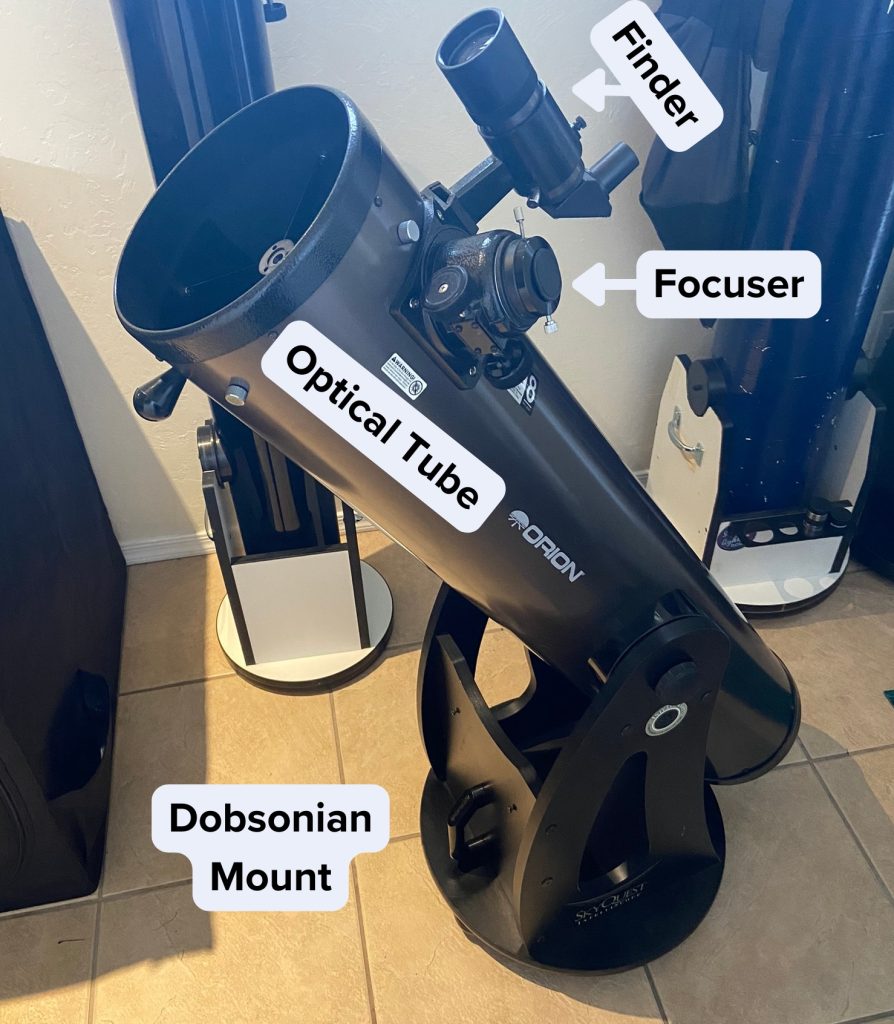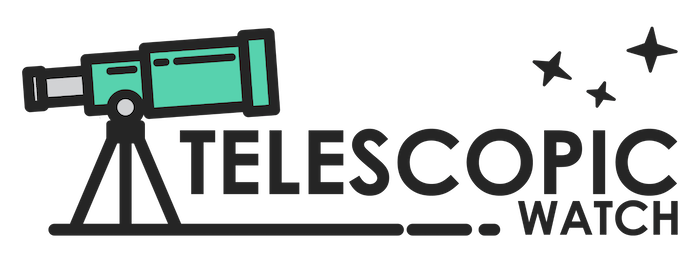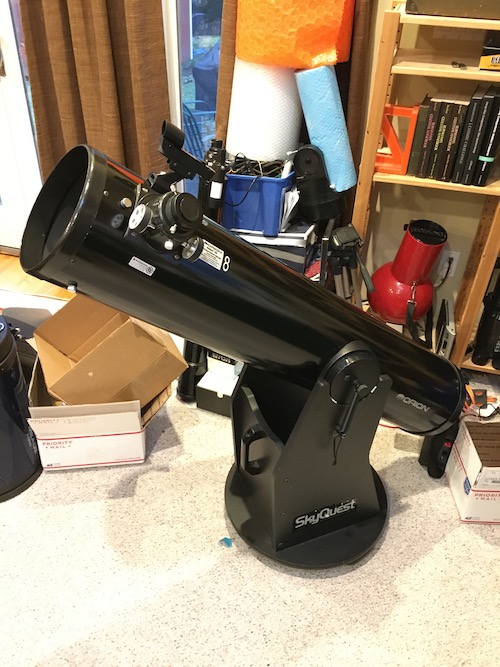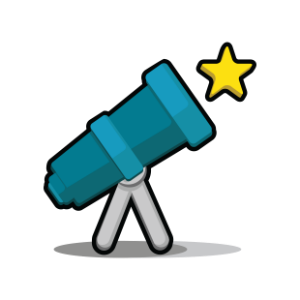The Optical Tube

The Orion SkyQuest XT8 is an 8” (actually 205mm or 8.1”) f/5.9 Newtonian reflector with a focal length of 1220mm, a fairly simple design. The primary mirror is made of plate glass.
Like most Newtonian reflectors, I need to align (called “collimating”) XT8’s mirrors fairly often, but not every single time I use the telescope. This is a relatively easy procedure and not something to be afraid of.
The tube of the XT8 is about 48” (1.2 m) long and, as such, fits across the back seat of most vehicles.
A Good Focuser to Complement
The focuser on the XT8 is a high-quality, single-speed 2” Crayford focuser. There is not a single plastic component to it.
I’ve noticed that the newest versions of the XT8 have added a brass compression ring to the focuser and its 1.25” adaptor, an improvement over the older thumb screw design, which tended to leave marks on my eyepieces and accessories.
The 1.25” adaptor also has T threads to attach a DSLR or mirrorless camera. But I don’t find this very useful given that the XT8 isn’t designed for long-exposure astrophotography and a smartphone is better for taking pictures of the Moon and planets.
Limited Accessory Offerings
The XT8 comes with a single eyepiece—a 25mm Plossl providing 48x magnification. I don’t see it as a bad eyepiece, but you’ll of course want additional eyepieces for higher and lower magnifications, particularly for good views of the Moon and planets.
A smartphone adaptor for taking simple shots of the Moon and planets is also included, and it clamps onto most 1.25” eyepieces.
The XT8’s finderscope is a simple red dot sight. A finder like this would have been fine for a smaller telescope, but with a bigger scope like the SkyQuest XT8, I’d really like a reflex sight like the Telrad or a right-angle, correct-image magnifying finderscope—essentially a mini telescope itself—such as a 9×50 design.
The Material & Mechanism of XT8’s Dobsonian Mount
The SkyQuest XT8 is a Dobsonian telescope that pivots up-down and left-right on Teflon pads. There are no locks, clutches, gears, or knobs to turn. I just push and pull the scope around the sky. Even at high magnifications, this is surprisingly easy for me to do, and the silky-smooth motions of the telescope make tracking and aiming the scope a breeze.
The regular XT8 uses springs for tensioning the altitude bearings, which allow the scope to pivot up and down. The telescope is prone to tipping over if it is slightly top- or bottom-heavy, due to the small bearings providing a smaller fulcrum and any imbalance making the whole tube act like a lever. This is actually quite helpful, but the springs look a little silly and are difficult to attach and remove.
My main gripe with the SkyQuest XT8’s mount, besides the small bearings, is the fact that it is made of particleboard. If I chip the paint/veneer, I will expose what is basically pressed-together sawdust, which quickly warps and rots. Also, particleboard is incredibly heavy, which is why the base of the Orion SkyQuest XT8 weighs a little over 20 lbs.
Thankfully, if the base is damaged or simply breaks your back, you can make a new base out of ¾” plywood for relatively little money, which will weigh less and probably look better, even with modest tools and skills. Several aftermarket vendors also offer custom new bases for your SkyQuest XT8, or indeed, any commercial Dobsonian telescope.
Should I buy a used Orion SkyQuest XT8?
The XT8 has been around for 20 years, and not much has changed. Older XT8s have a slightly lower quality rack-and-pinion focuser, and the oldest units only have a 1.25” focuser, so expect to pay less for one of these.
But if the mirror coatings are in good shape and the base isn’t damaged, there’s not much that can go wrong with a used unit. At worst, you can always build a new base out of plywood for a relatively low cost.
Alternative Recommendations
The Orion SkyQuest XT8 doesn’t come with a lot of accessories or features for the money compared to “deluxe” Dobsonians which hardly cost much more, but it’s a perfectly fine scope. However, here are some of our top alternative picks.
Under £600
- The Apertura AD8/Zhumell Z8/Orion SkyLine 8 includes a lot more features and accessories than the XT8, such as a 9×50 instead of a red dot finder, two eyepieces, and even a built-in dual-speed Crayford focuser and cooling fans. Upgrading the XT8 to include all of these features would cost several hundred dollars, which is a massive jump compared to the price of just getting the AD8/Z8.
- The Explore Scientific 10” Hybrid Dobsonian outperforms an 8” Dob like the XT8 by a large margin, but includes a similarly bare-bones set of accessories and features like the XT8 with the added requirements of a shroud and requiring assembly of the truss tubes before use.
- The Sky-Watcher Virtuoso GTi 150P has less light gathering or resolving power than the XT8, but comes in an ultra-compact and portable package that fits in a suitcase or backpack. The Virtuoso GTi 150P also features full GoTo and motorised tracking features, controlled with an app on your smartphone or tablet. The manual Heritage 150P is identical to the GTi 150P apart from the lack of electronics.
£600-£800
- The Apertura AD10/Zhumell Z10/Orion SkyLine 10 features the same accessories and feature upgrades as the AD8, with a dual-speed focuser and 9×50 finder being included by default along with a plethora of other accessories. The extra 2” of aperture doesn’t translate to a significant increase in weight or bulk, but will show you 56% brighter images and has 25% more resolving power.
- The Celestron StarSense Explorer 8” Dobsonian is very similar to the XT8, with the same basic set of accessories. However, the StarSense Explorer 8” has a base with cutouts to reduce weight and uses Celestron’s StarSense Explorer technology to assist in finding objects in the night sky using your smartphone piggybacked on top of a special-purpose bracket on the scope.
- The Sky-Watcher 8” FlexTube Dobsonian has the same optics as the XT8 and feature-wise is similar other than the inclusion of a 9×50 finder in lieu of a red dot and the addition of a 10mm eyepiece (120x) to the mix. The collapsable tube is its hallmark feature and allows the scope to take up slightly less storage space, at the expense of requiring a shroud and more frequent collimation. The altitude bearing design is also noticeably inferior to the XT8 or AD8.
What can you see with XT8?
The XT8 shows me a lot, especially under clear and dark skies. However, no matter where I’m, the Moon and planets are fabulous.
- Tiny lunar details just a few miles across, like craters, ridges, and volcanoes known as lunar domes, can be seen on a steady night, as can the phases of Mercury and Venus.
- On Mars, the XT8 shows up to a dozen or so features to the trained eye when Mars is close to Earth.
- Jupiter’s cloud bands show lots of festoons and swirls. The Galilean moons of Jupiter are no longer mere pinpoints but tiny disks, with hints of colour.
- Saturn shows several moons and intricate cloud bands, along with the Cassini and possibly Encke divisions.
- Uranus and Neptune are merely bluish-green dots, though you might be able to spot Neptune’s largest moon, Triton.
The quality of many deep-sky objects I can view with the SkyQuest XT8 or any telescope, is heavily dependant on the light pollution I’m under.
Galaxies under dark skies look fabulous with the XT8; I have no trouble spotting the spiral arms of M51 and M33, the H-II regions of M82 and M101, and all sorts of dust lanes and details in several hundred of the brightest galaxies. But under light-polluted skies, the faint details and sometimes whole galaxies themselves completely vanish from view.
Many large, bright nebulae are similarly affected.
Open star clusters and globular star clusters, as well as smaller planetary nebulae, aren’t as affected by light pollution. Even from the suburbs, I’ve no trouble resolving many of the globular clusters like M13 and M15 into individual stars, and open star clusters are still majestic and colourful.



Just to clarify….the 6mm? Not the 9, 15, or 20?
Zane, your newbie is back and a proud new owner of an XT8! A few ridiculous questions:
1. All objects look yellow. How do I get colour?
2. Saturn doesn’t look much different than I remember it in my Celestron 76eq when I was a kid. This scope is 3x to 4x the price, so I was hoping for more – it’s kind of small.. Is it that I need more eyepieces to make Saturn look even bigger? If so, which ones do you recommend? (please link!)
3. How big of a difference will it make if I drive 20-30 minutes outside of town?
4. As ridiculous as this may sound, is any other than the sun dangerous [for your eyes] to look at through the scope?
Thanks again!
It seems everything is great about this scope, except the accessories. Would you recommend configuring our own set from Orion’s build-a-scope website?
https://www.telescope.com/Telescopes/Dobsonian-Telescopes/Build-A-Scope-Dobsonians/Orion-Build-A-Scope-8-Classic-Dobsonian-Telescope/pc/1/c/12/sc/31/p/102032.uts?refineByCategoryId=31#build-a-scope-container
If so, what would you recommend in terms of a finder scope, focuser, and filters? For eyepieces, I’ll go gold-lines, based on your input there (thanks).
Please help!! Assuming equal price, which should I pick: XT8 or Skywatcher 8″ Dobsonian?
Unfortunately, the Zhummel Z8/Apertura AD8 are not sold in Europe it seems…
Thank you for this great review and website by the way!
Hi Zane, I have recently ordered the Orion XT8 and was wondering what additional eyepieces I should buy. I’d like to enhance my viewing of nebulae so any suggestions on how I can do this as I am brand new? I’ve received advice to say if I get a 2″ eyepiece and a filter this would be optimal but I’m not sure where to start at all with the best options for this. Many thanks, Sophie
Hello. I’m thinking on buying an XT8 but I live in Mexico and there is not a lot of options regarding accessories. I found this Orion set but I dont know if it is worthwhile or if it is better to buy some of the individual eyepieces you mentioned. This is what the set contains (all in 1.25″):
5 Sirius Plossl telescope eyepieces – 40mm, 17mm, 10mm, 7.5mm, and 6.3mm
6 eyepiece filters – 5 colour planetary filters and a 13% transmission neutral-density Moon filter
A Shorty 2x Barlow lens
Thanks!
Hi, I live in a town which suffers from a fairly high light pollution (orange/red zone, 5th/6th class according to the Bortle scale) and has more LED street lights than the sodium ones, so the LP filter would not be much use. Most of my observing time is going to be spent in a backyard or a roof of my house, so I’ll have to deal with the light pollution most of the time, but I’ll be able to escape the light polluted area several times a year. So would You still recommend 8 inch dob over 6 inch, if the major part of my observing time is going to be spent in the light polluted area? I have no problem with affording the 8 inch, but I just want to know if it’s still worth the additional money I’ll pay for it compared to the 6 inch dob. Thank You